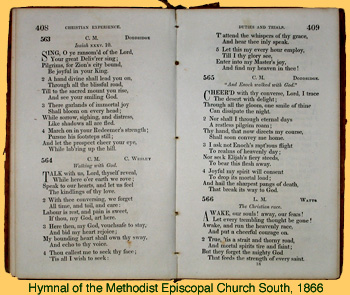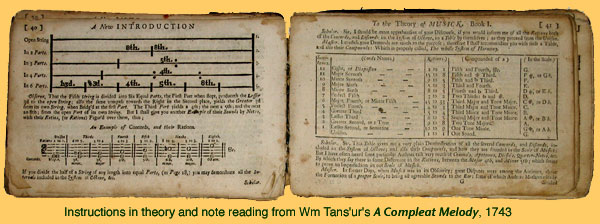
It is easy to assume that hymnals have always looked the way they look today: a four-part setting of the tune in closed score with the hymn (text) fully interlined. Actually, this now familiar format dates from about the 1930s. In the period covered by this anthology hymns were not as closely associated with specific tunes as they are today. A given hymn could be sung to a number of different tunes that matched the meter of the text. In addition hymns and tunes were most often printed in separate books. Tunebooks were either completely separate books or were appended to hymnals: hymns in the front, tunes in the back as were the tunes in later editions of the Bay Psalm Book. Some tunebooks contained no text at all and some had a verse or two of a hymn (seldom complete) interlined with the music. By the mid-19th century the so called "hymn and tune book" began to appear, but even in these a number of hymns were printed in poetic form below a harmonized tune; and although hymnals in this format began to appear in the pew in the 1850s and 60s, this practice remained uncommon until the early 20th century. Hymnals (text-only) were commonly held by parishioners in the pew. Tunebooks were normally in the hands of the music leader and the choir or served as the "textbook" for singing schools.
 Tunebooks served the church and the very popular singing schools and singing societies. With few exceptions tunebooks included a section at the beginning of the book that contained instructions in music theory, note reading, and sometime vocal production.
Tunebooks served the church and the very popular singing schools and singing societies. With few exceptions tunebooks included a section at the beginning of the book that contained instructions in music theory, note reading, and sometime vocal production.
All of the 18th-century tunes were selected from tunes most often printed in American collections as identified by Richard Crawford in The Core Repertory of Early American Psalmody (A-R Editions, 1984). These were divided into three categories: English common tunes, English "West Gallery" tunes, and the tunes by American composers often referred to as the "Yankee Tunesmiths." The early 19th-century tunes were selected by the editor to represent styles in four categories: tunes of the reformers, sunday-school songs, African American tunes, and folk hymns.
Every effort was made to find the first American printings of the representative tunes. One reason for this effort is that first printings are most likely to present the tune and harmony in the way intended by the composer. This is more true, of course, with tunes composed by Americans and perhaps less true of reprints of English tunes as they first appeared in American collections. In either case subsequent compilers often felt free to make changes. The harmonies of early American tunes (and sometime the tunes themselves) printed in the 19th-century were most often greatly altered to make them conform to a more "scientific" model.
Most tunes appear in their first printings. In some cases later editions of tunebooks were used when first editions were not available. In a few cases later printings of tunes were deliberately used because of the tunebook in which they were printed. For example, no first printings in this anthology were associated Little and Smith's An Easy Instructor, the tunebook that introduced the much used shape-note system. So the tune Montgomery, as printed in this important collection, was chosen even though it is not a first printing.
A practical advantage to locating first printings is that they were often published in ground-breaking tunebooks such as John Tufts' An Introduction to the Singing of Psalm Tunes, one of the first collections with singing instructions that supported the Regular Singing movement designed to teach church goers to sing by note rather than by rote; and James Lyon's Urania, the first large collection of tunes to serve the growing singing-school movement.
Other anthologies of 17th, 18th, and 19th century American hymn tunes, all far more complete in bibliographical information, have been published in the last 25 years. Two are recommended: American Hymns Old and New in two volumes by Christ-Janer, Hughes, and Smith (Columbia University Press, 1985); and The Core Repertory of Early American Psalmody by Richard A. Crawford (A-R Editions,1984) Much of the bibliographical information on the 18th century tunes presented in this anthology is taken from the latter work.
I had hoped to supply recordings of real people singing each of the examples but this proved expensive and complicated. Disappointed, I rendered each of the examples in MIDI instead which was far easier but a poor substitute for this vocal art. I have made every effort to choose instruments that bring out textural clarity. For the melody and bass parts I used brighter instruments (oboe, bassoon, contrabass). For other parts I used instruments that spoke less forcefully (recorder). I added trills, dynamic variations, fermatas, and ritards where marked or where a human touch seemed appropriate. My choice of tempo came partly from my experience with the shape-note singing tradition and partly from my own musical judgment.
On my Mac using Quick Time textural clarity and the balance between melody and other parts along with the added nuances sound good. Despite my best efforts, however, it's still MIDI--a bit mechanical. Unfortunately, MIDI files are interpreted by the synthesizer in your computer. Hopefully, the recordings will sound as good on your computer as on mine but there is no guaranty.
Images from the Ainsworth Psalter and the Bay Psalm Book are used by courtesy of the Institute for the Studies in American Music. They were taken from two monographs published by I.S.A.M.: Monograph #5, The Music of the Bay Psalm Book by Richard Appel; and Monograph #15, The Music of Henry Ainsworth's Psalter by Lorraine Inserra and H. Wiley Hitchcock. Images of the tune "Hallelujah" and title page were taken from Wyeth's Repository of Sacred Music, Part Second, Da Capo Press, 1964. Images of the tune "Weeping Mary" and title page were taken form The Social Harp, University of Georgia Press, 1973. Images of the tune "Wells" and title page were taken from Urania, Da Capo Press, 1974. Images of the tune "Majesty" and the title page from The Singing Master Assistant were taken form The Complete Works of William Billings, Vol. II, The American Musicological Society and The Colonial Society of Massachusetts, 1977. All other images from 18th century tunebooks are courtesy of the Library of Congress. Bethel University student Claire Erickson transcribed several of the lengthy tunebook prefaces.